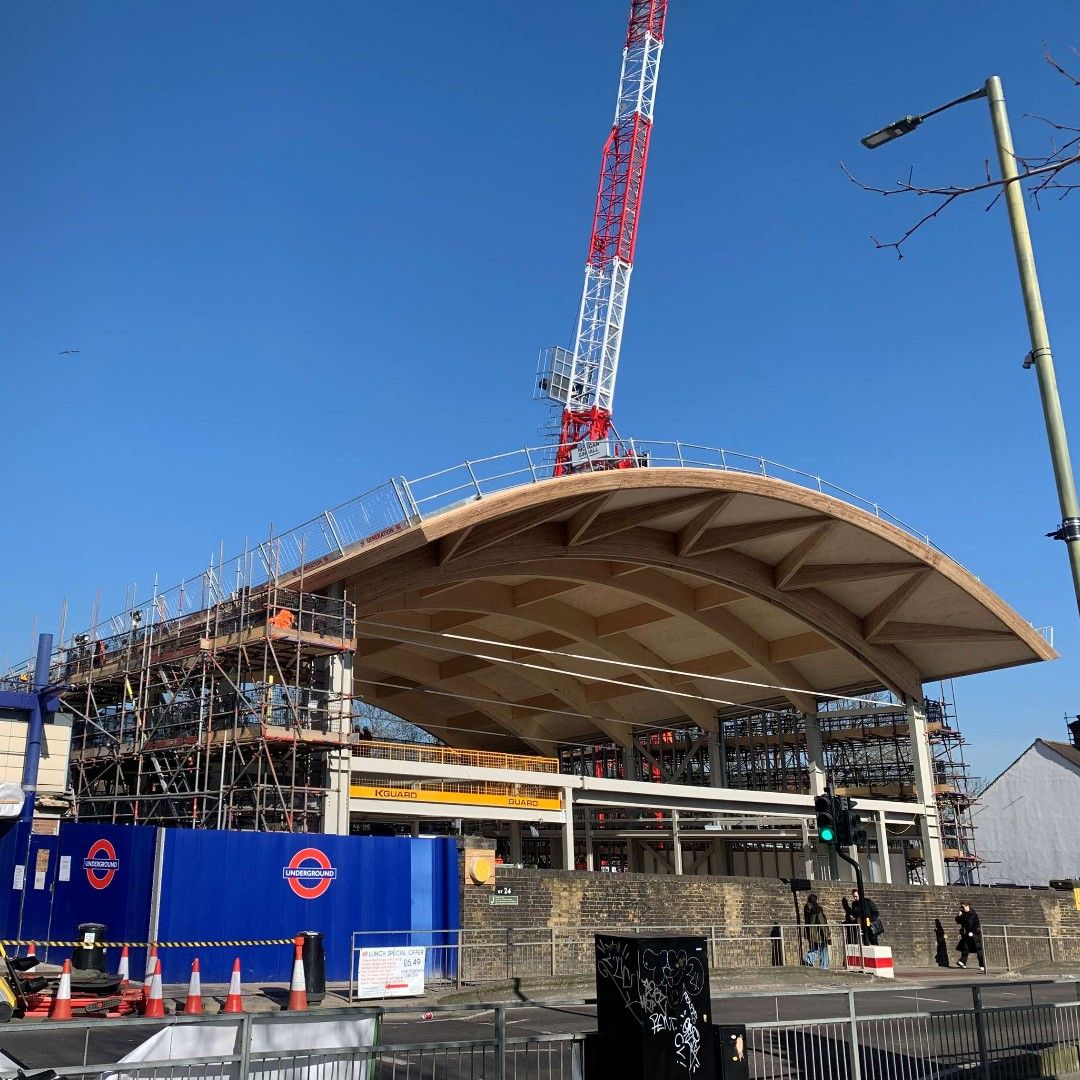
With Aphex, we can avoid the pitfalls that occur when people don’t see the clashes, which allows our planning to be more efficient and realistic.
The project
The Colindale Station Redevelopment project is a major upgrade of an existing London Underground station. The project involves building a new station concourse across the Northern Line rail cutting, providing step-free access, and dramatically increasing capacity for one of London's fastest-growing residential areas.
The architectural design draws inspiration from the nearby historic Hendon Aerodrome. It features structural timber glulam arches and beams that create a distinctive hangar-like appearance. When complete, the station will serve a population that has more than doubled due to local housing regeneration initiatives.
We spoke with Matt Jones, Project Manager at Morgan Sindall Infrastructure, about how his team used Aphex to coordinate this complex rail infrastructure project while maintaining live train operations.

The challenge of visual coordination
Like many major infrastructure projects, the Colindale team had the complex challenge to coordinate across multiple work zones and contractors. The project required precise planning to work around live train operations while managing numerous subcontractors in constrained spaces.
"We had a room with about 25 people — subcontractors, engineers, and project managers — all working with PowerPoint presentations and general arrangement drawings," Matt explains. "People would manually update little arrows and boxes showing what they were doing each week."
This approach created several problems. Updates weren't current, leading to longer meetings. Multiple people couldn't easily collaborate on the same system, and subcontractors found it difficult to contribute effectively.
"It's hard to visualise who will need what space when they arrive on site. Without that information and visibility of what each party needs, you can't translate the plan to site effectively."
Matt Jones, Project Manager
The power of spatial planning
The breakthrough came when the team implemented Aphex's mapping capabilities. Unlike spreadsheets and PowerPoint, Aphex allows teams to create map views directly connected to tasks in the live schedule. Teams can overlay their work activities directly onto site maps and technical drawings.
Aphex automatically detects when multiple activities are planned in the same location at the same time, highlighting potential clashes before they occur on site. Teams can define work areas, exclusion zones, material storage locations, and access routes, creating a comprehensive spatial understanding of the project.
Matt emphasises the importance of showing actual working areas, not just simplified representations. "I encourage engineers to show the actual laydown and full working areas when using Aphex. If they're installing cladding along one wall, it's not just a small rectangle — it includes a couple of metres for exclusion zones, the full length of work, and areas for material storage."
This detailed spatial visualisation transformed how the team coordinated work. Instead of discovering clashes on site, they could identify and resolve conflicts during the planning phase.
As Matt explains, this avoids the common problem of congestion on a work site.
We can now avoid the pitfalls that occur when people don’t see the clashes, which allows our planning to be more efficient and realistic.
Matt Jones, Project Manager

Maximum site utilisation
The impact of this improved coordination was most evident during a critical phase in late summer 2023, when the team needed to maximise every inch of their constrained site.
"We had a live operational railway on the Northern Line, both north and southbound. We were working on the platform, doing foundations. On the east side, we had the car park operational while demolishing and installing structural columns. On the west side, we were piling on top of the retaining wall, adjacent to the live railway."
Matt describes this as utilising "every inch of ground on a postage stamp site." The success of this complex coordination demonstrated Aphex's value in optimising concurrent activities.
"Aphex helped us plan access routes, material movement, work areas, and laydown areas, which enabled us to confidently plan the works and execute them. When people arrived on site, they knew where to store materials and what the access routes were — it wasn't just happening when they walked onto site."
Matt Jones, Project Manager
A structured planning process
The team developed a systematic weekly planning routine centred around Aphex:
"We have Monday planning sessions for our four-week lookahead. Engineers update their plans on Monday and Tuesday. On Wednesday, we hold the Aphex coordination meeting and update everything. We take comments, distribute them to the team, update Aphex again, and publish on Friday, ready to brief the client on Monday."
This structured approach created accountability and ensured everyone stayed aligned throughout the project. It has also improved team dynamics and collaboration.
"The team is more focused and directed because it's easier for them to plan their work. They can simply log in and see what everyone else is doing.”
The visual nature of the tool has proven particularly valuable for engaging different audiences, from technical engineers to non-technical stakeholders.
"Subcontractors tend to be visual people. Seeing things in a long schedule or Gantt chart can get very complicated on big projects. But when they can see what's happening spatially, it becomes much more accessible and understandable."
Matt Jones, Project Manager
Commercial benefits
Another application has been using Aphex's analytics for commercial purposes. Aphex’s Insights feature provides detailed data about delays and their causes across the project.
"The insights give you pie charts showing what clashes occurred and what caused them. This has real commercial potential because our quantity surveyors can see why certain activities didn't happen, and they can build stronger cases for claims and variations."
This data-driven approach helps justify changes and commercial claims with data rather than subjective assessments.
Looking ahead
The team plans to use Aphex on future step-free access schemes across London Underground's network.
"If you implement Aphex before a project gets fully up and running, it's extremely useful because you can see how you're going to phase the work. This provides clarity to the client, your wider business team, and subcontractors about what you're going to do and when."
Matt's advice for other teams considering Aphex is straightforward.
"It's such a useful way of demonstrating what's going to happen on site and streamlining the planning process. It's not overly complicated, and it's not too simplistic. It hits the right level for people to use and demonstrate what will happen and how on a project."
The success at Colindale demonstrates how digital planning tools can transform complex infrastructure delivery, turning potential chaos into coordinated execution while maintaining the flexibility needed for challenging construction environments.

Heading
Lorem ipsum dolor sit amet, consectetur adipiscing elit. Suspendisse varius Duis cursus,









